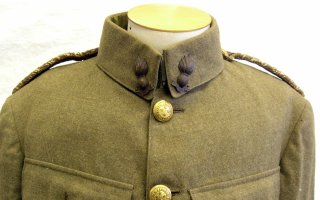Khaki Uniforms Were the Original Military Camouflage
While known for the casual pants, khaki has a long history as the first widespread military camouflage.
Half way around the world the Empire of Japan was outfitted in a similar shade of uniform, one whose origins go back to the Russo-Japanese War (1905-05). The Japanese had replaced its white cotton summer uniform in 1904 with the new M1904 khaki uniform, which was likely inspired by the colors used by its then-close ally Great Britain. This uniform was used throughout the First World War, and then modified and modernized in 1930, but retained the same color at the “tropical” or summer uniform throughout the Second World War, by which time the Japanese were outfitted in a uniform close in color to their then-British enemies.
Ironically, the British had found that khaki drill was actually impractical in the jungles of Burma, and actually dyed the uniforms green while exploring options for more suitable jungle uniforms. The result was a Jungle Green (JG), which had a significant flaw, in that it darkened quickly as soldiers sweated in the cotton uniforms. The French experienced a similar flaw when they too replaced the khaki with American colored Olive Drab (OD) for use in Indochina in the late 1940s and early 1950s.
It wasn’t just the Europeans or the Japanese who utilized khaki, as so too did the American military, which first adopted khaki during the Spanish America War in 1898. Until that time the United States Army was outfitted with the M1883 fatigue blouse in blue. However, the large numbers of volunteers—as well as the fact that soldiers were falling prey to heat exhaustion and dehydration—forced the army to experiment with lighter-colored and lighter-weight materials. The United States thus adopted the “khaki cotton drill” and in 1903 the army authorized these as the official hot weather fatigue and field dress.
The American use of khaki continued following the First World War in tropical climates notably for the United States Navy and United States Marine Corps. The United States Army also utilized a khaki field uniform—the “chino” style—until the outset of World War II as the summer service and field dress. It was replaced by specialized combat uniforms, and only briefly saw use with U.S. Army units in the Pacific. However, the khaki did have its influence on the M41 field jacket, which retained a “khaki” shade, which was finally replaced with the Olive Drab colored M43 field jacket.
The United States Marine Corps retained khaki as training and walking out uniform, while khaki remains in use with the United States Navy for chief petty officers and officers, who are often known as “khakis” for their uniforms by the enlisted men.
While no longer practical as camouflage, the uniforms still have their place not only with the U.S. Navy, and with other nations as a walking out uniform, but also are part of a shared history of military uniforms—for few patterns or colors have been as widespread as this one of the color of Indian “dust.”
Peter Suciu is a Michigan-based writer who has contributed to more than four dozen magazines, newspapers and websites. He is the author of several books on military headgear including A Gallery of Military Headdress, which is available on Amazon.com.
This article first appeared in November 2020.
Image: Wikimedia Commons

